

This paper examines economic development policymaking in a small town of 25,000 residents. This study explores the impacts that new industry created in a small town. Impacts are analyzed in two contexts: 1) in terms of socioeconomic impacts measured through U.S. Census data, and 2) in terms of perceived impacts, generated through a survey of former community leaders. This study attempts to answer several questions: Who made key decisions as it related to industrial economic development in a small town? Do local leaders believe their decisions to accept industrial development led to an improved quality of life?
Garden City, a growing southwest Kansas community of approximately 25,000, is one prime example of an agriculturally-dependent town where leaders used business subsidies to promote growth. In 1979, Garden City attracted IBP, the world's largest meat-processing facility, offering the company $3.5 million in property tax relief and $100 million in industrial revenue bonds for construction of a 70,000 square-foot manufacturing facility. The decision to attract IBP was particularly attractive to community leaders because it built upon the community's agricultural base, offering increased employment at the local level (Broadway Stull and Podraza 1994:24). Garden City, already the largest exporter of beef in southwest Kansas, was a prime locational choice for a beef-packing plant. In a two-decade time frame, Garden City grew 87 percent, from 14,790 residents in 1970 to approximately 25,000 residents in 1990.
Furthermore, Garden City is an ideal candidate for studying small-town economic development decisionmaking because the city conducted an in-depth, year-long study in 1980, a year before IBP arrived. The study, conducted by the Battelle Institute, assessed community attitudes of leaders and residents as it related to expected impacts of new industry and community growth. Sociologists also have conducted extensive studies of this community, therefore providing a good research base with which to evaluate the impacts of growth.
Figure 1
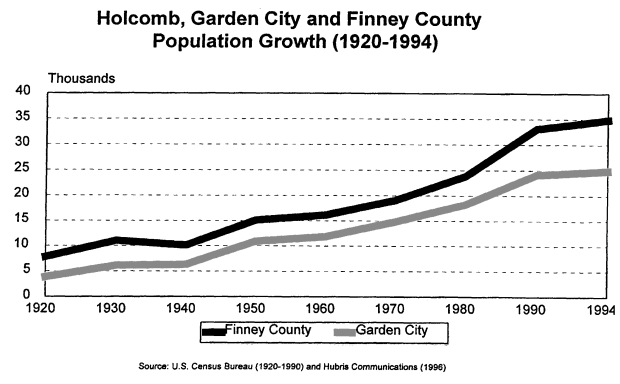
Originally, Garden City was dependent on the sugar beet industry, until the local factory closed in 1955 because of outdated machinery and the declining demand for sugar beets (Finney County Historic Tour Guide 1994). Since the development of new innovations in irrigation technology, Garden City's economy grew. In the mid-1960s, farmers began to use the new technology of center-pivot irrigation to cultivate cattle feed grains, an industry which has since grown into the surrounding counties (Broadway 1994: 33). The innovation of boxed beef, first developed and marketed by IBP in 1967, allowed meatpacking plants to relocate from urban centers to less expensive rural places, such as Garden City (Broadway 1985: 5).
Meat-packing employment has brought rapid change to the community since the 1970s. Changes in income, education, and occupation -- three indicators of socioeconomic status -- convey a greater understanding of the social homogeneity or diversity of a small town (Swanson 1979: 199-200). An analysis of these three socioeconomic indicators in Garden City indicate that growth have not been altogether favorable.
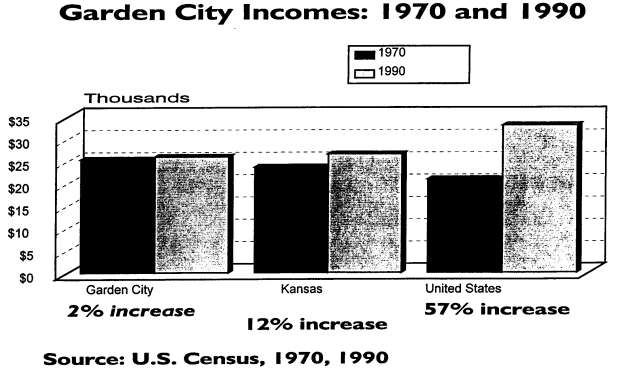
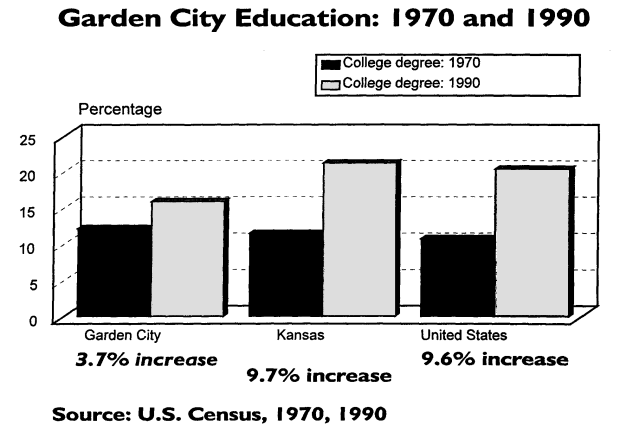
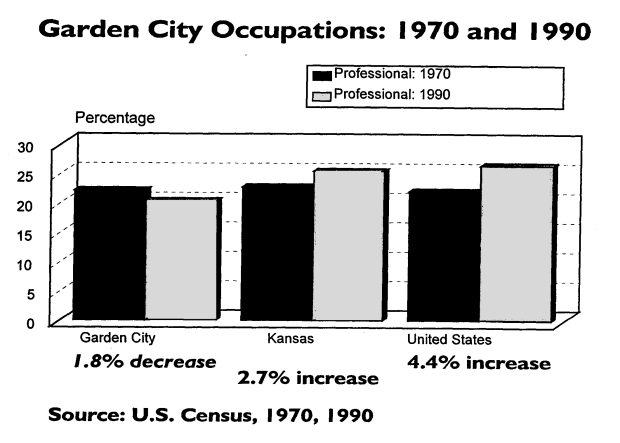
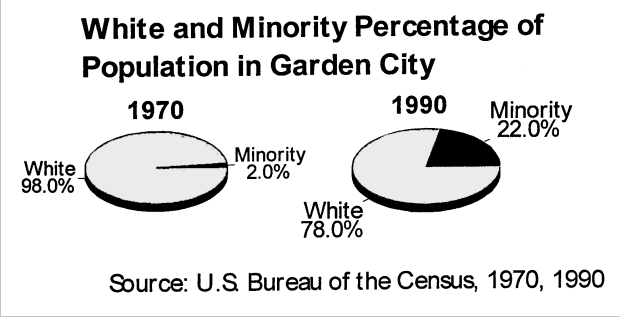
The introduction of meatpacking resulted in a dramatic demographic alteration in Garden City, forcing community officials to deal with a host of problems. Some of the most serious problems include increases in crime, strains on the health care system, increases in minority workers, language and cultural differences, increases in demand for low-cost housing, strains in infrastructure and increases in low-paying jobs (Broadway Stull and Podraza 1994: 24-28). The socioeconomic impacts of beefpacking were large. The following section explores who made the decisions to attract this industry, and how these leaders evaluate their decisions today.
The survey relied upon a list of 79 persons identified by the Battelle Institute in 1980 as community leaders. Although the Battelle Institute report did not indicate how the list was compiled, the researchers stated that the list represented "influential community leaders" knowledgable about Garden City in state and local government, education, business and other private and public sector functions. I surveyed as many of these former community leaders as I could locate, asking them to name the top influentials in selected sectors of community leadership. Of the 51 persons whom I could locate, 13 individuals completed and returned the mail survey. The survey response rate is 25 percent.
Second, the survey found that several leaders named as key influentials -- a cattleman and a farmer -- were not surveyed in the original Battelle study. These leaders may have been overlooked, yet they may have been extremely influential. Perhaps the Battelle Institute failed to conduct in-depth analysis of all those who made policy before conducting the study.
Table 1 depicts the respondents' perceptions of whether the community's business quality of life factors have improved since the arrival of IBP. I expected the respondents to rate the business environment as better than before IBP arrived, given the opportunities for more business and more clients. Although respondents favorably perceive community factors relating to business, statistical analysis indicates this relationship is weak (see table 1). Former leaders apparently share little consensus that the quality of business factors have improved.
| Table 1 Perceived Improvement In the Quality of Life (Business Indicators) | ||
| Business Factors | Poor/Fair | Good/Excellent |
| Pre-IBP | 5 | 28 |
| Post-IBP | 1 | 32 |
I expected respondents to indicate that amenities have declined, given that rapid growth likely has contributed to environmental degradation and loss of a homogeneous, small town atmosphere. However, the statistical test of this relationship is inconclusive, as table 2 indicates. Former community leaders appear to share no consensus as to whether economic growth affected the overall quality of community amenities.
| Table 2 Perceived Improvement In the Quality of Life (Amenity Indicators) | ||
| Amenity Factors | Poor/Fair | Good/Excellent |
| Pre-IBP | 9 | 24 |
| Post-IBP | 12 | 21 |
| Chi square = 0.629; D.F.=1; Statistically insignificant <0.1 | ||
Finally, Table 3 illustrates the respondents' perceptions of whether the community institutional factors changed since the arrival of IBP. I expected respondents to indicate that intitutional factors have declined, given the influx of unskilled, indigent migrants and their impacts on the educational system, the housing market and public safety. However, statistical analysis shows that a positive relationship exists: respondents rated institutional factors as having increased slightly. The statistical analysis, nevertheless, shows that the relationship is weak.
| Table 3 Perceived Improvement In the Quality of Life (Institutional Indicators) | ||
| Amenity Factors | Poor/Fair | Good/Excellent |
| Pre-IBP | 9 | 24 |
| Post-IBP | 19 | 14 |
| Chi square = Statistically Significant at the 0.025 Level; Cramers V=0.3067 | ||
From the sample survey, one can only conclude there is no consensus as to whether the quality of life has changed. Respondents to the survey indicate they perceive approximately half (56%) of all quality of life factors to have remained the same over the last decade. As indicated in table 4, respondents are nearly divided as to whether the overall quality of life has improved or declined since IBP arrived. This is indicative of an increasingly pluralist society, where former leaders share no consensus as to whether the quality of life is becoming better or worse.
| Table 4 Perception of Quality of Life In Garden City: Before & After IBP | ||
| Pre-Beefpacking; Perception of Growth in Garden City (1980) | ||
| Positive | Negative | Don't Know |
| 57% | 20% | 23% |
| Post-Beefpacking; Perception of Growth in Garden City (1990-92) | ||
| Improved | Declined | Same |
| 22% | 22% | 56% |
| Source: Battelle Institute (1981:156) and 1996 Survey of Former Community Leaders | ||
Before IBP arrived, community leaders had high expectations for new industry in Garden City. Yet, this post-industry analysis indicates that former community leaders do not agree the benefits have been clearly positive. Apparently, consensus has eroded among former decisionmakers. Consensus may have eroded because former leaders may feel ambivalent about the changes that have overtaken Garden City. This potential ambivalence may be a consequence of Garden City becoming more pluralistic.
Apparently, Garden City is becoming more pluralistic due to the influx of rapid growth and diverse populations. Former opinion-makers no longer agree that the quality of life in Garden City is becoming better, despite new industry and the growth in employment.
Planners must anticipate and plan for more than the simple "hard infrastructure" costs of growing and diversifying communities; they must be willing to take additional information on larger social impacts to business leaders and discuss the implications of community growth. Planners must be willing to investigate the intangible impacts of community needs, such as those for bilingual education, low-income housing, and new types of social services to serve diverse, multicultural populations.
As guardians of the public good, planners also should give weight to the opinions of the residents at large, undertaking focus group surveys to measure the perceived impacts of certain types of economic growth that likely will emerge in the community. As planners coordinate community projects that may have large social impacts, they must seek out a greater array of citizens. To merely survey community leaders is to invite social disruption.
When planning for change, small communities such as Garden City should visit and consult with similar communities that have absorbed diverse populations. For example, when IBP announced it was opening a plant in Lexington, Nebraska, community leaders created a Community Impact Study Team to determine the impact of the packing plant upon the town. Members of the Nebraska team convinced IBP to provide some financial assistance to furnish coaches for a mobile home park and create a day-care center at the meat-packing plant (Broadway Stull and Podraza 1994: 27).
Garden City has become a more vibrant, ethnically-diverse and interesting community since the arrival of beefpacking. Yet, as Garden City moves into the 21st century, local planners must seek to help the local leadership improve the socioeconomic status of new members of the community. This can only come about if community leaders are willing to establish some consensus on this issue, clearly a difficult, but necessary process. Without agreement on this issue, the community may risk eventual decline or extinction.
Battelle. 1980 and 1981. "Clarifying Socioeconomic Impacts and Mitigation Measures Related to the Economic Development of Finney County, Kansas." Ohio: Battelle Columbus Division.
Broadway, Michael. 1985. "The Characteristics of Southeast Asian Refugees Residing in Garden City, Kansas." The Kansas Geographer. 19: 5-18.
Broadway, Michael, Stull, Donald and Podraza, Bill. 1994. "What Happens When the Meat Packers Come to Town?" Small Town Journal: Vol. 25 (1): 24-28.
Finney County Historic Tour Guide 1994 (brochure)
Isberg, Gunnar. 1981. "Toward a Rural Planning Approach for Evolving Communities." Small Town Journal 12: 15-18.
Keller, Lawrence F. and Wamsley, Gary L. 1978 " Small Government as an Interorganizational Governance Network," Southern Review of Public Administration. 2 (3): 277-300.
Marketview Survey. 1993. Garden City.
Rossi, Peter H. 1960. "Power and Community Structure." Midwest Journal of Political Science. 4: 390-401.
Rubin, Irene and Rubin, Hebert. 1987. "Economic Development Incentives: The Poor (Cities) Pay More," Urban Affairs Quarterly. 23(1): 37-62.
Swanson, Bert; Cohen, Richard and Swanson, Edith. 1979. Small Towns and Small Towners: A Framework for Survival and Growth. Beverly Hills: Sage Publications, Inc.
Angela Donelson
Analyst, Department of Development Services
City of Sierra Vista
1011 N. Coronado Drive
Sierra Vista, AZ 85635
(520)458-3315